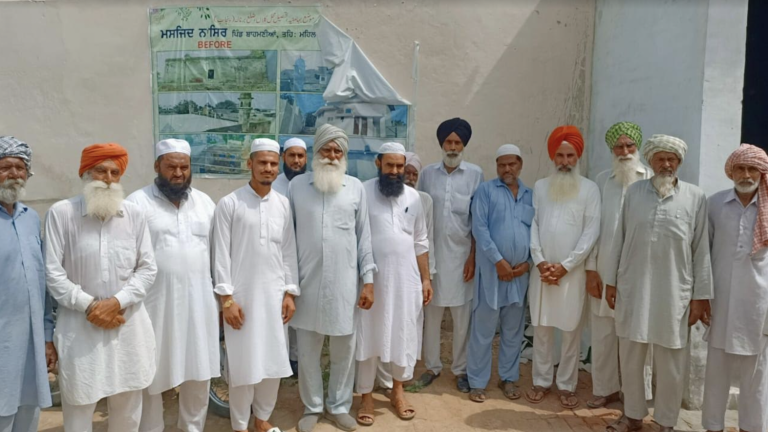
[ad_1]

In the serene landscapes of Punjab’s Barnala district in the northern part of India, the melodious Muslim call to prayer resounds throughout the day. While communal tensions and clashes occasionally make headlines, a different narrative unfolds in the villages of Kutba Bamaniya and beyond.
Amid this backdrop, a prepartition mosque stands tall as a symbol of history, resilience and a shared commitment to coexistence. Sikhs form the bulk of Punjab’s population. According to census figures from 2021, the population of Punjab is made up of 57.7% Sikhs, 38.5% Hindus and less than 2% who identify as Muslims.
Led by determined Buta Singh, the villagers, mostly Sikhs, of Kutba Bamaniya embarked on a mission to not only restore the mosque’s physical structure but also to preserve the legacy it represents. The mosque, a witness to India’s history, has become a beacon of unity.
READ: Sikh Temples A Lifeline For Flooded Areas Of The Himalayas
Singh said non-Muslims used to maintain this mosque in the past, even though it had fallen into disuse after the partition of India in 1947 that led to the creation of Muslim-majority Pakistan and a Hindu-dominated India.
“We previously installed the Granth Sahib (the Holy book of Sikhs) in the village gurudwara. Later, when a decision was made to restore the mosque, members of the Sikh community wholeheartedly supported the Muslims in this endeavor,” said Buta Singh. “Our village residents coexist in complete harmony and tranquillity, rejoicing in each other’s religious festivals.”
Preserving the past: The scar of partition
The partition of India left behind scars that impacted religious sites across the region. The abandonment and damage of numerous sacred places was a painful reminder of the violence that accompanied the partition. However, efforts to restore and rebuild these sites emerged over time, driven by a collective desire to heal wounds and promote harmony.
Efforts to restore religious sites damaged nearly seven decades ago have been ongoing. Communities, governments and organizations have come together to preserve cultural heritage and foster reconciliation. The restoration of temples, mosques and gurudwaras by diverse religious groups exemplifies the power of unity amid diversity.
The picturesque village of Kutba Bamaniya, for example, has a unique story to tell. While Muslims had migrated to Pakistan during the partition, a few families remained behind. The decision to restore the mosque was not merely an act of rebuilding — but a gesture to reclaim shared history and reaffirm unity.
“Our village sets a global example of unity,” said Buta Singh, aptly capturing the sentiment.
Amrinder Pal Singh, who lives in Kutba Bamaniya, said the village stands as a beacon of love and that its people’s shared history endures.
“The mosque’s construction was a collaborative endeavor, reflecting the spirit of all communities involved,” he said. “We urge the people of Punjab and India to emulate our communal harmony. Regrettably, we haven’t received government support. The creation of both the gurdwara and the mosque was solely through our collective efforts.”
Championing unity: Beyond religious boundaries
Both the Indian and Pakistani governments have occasionally taken steps to restore and preserve religious places affected by partition. They have allocated funds for the maintenance and renovation of historically significant religious sites.
But local communities residing near damaged religious places have often taken it upon themselves to restore and maintain these sites. This includes Sikhs, Hindus, Muslims and other religious groups collaborating to rebuild and preserve shared heritage. Interfaith groups have come together to restore and maintain religious places.
These initiatives emphasize unity and cooperation among different religious communities. The restoration of the mosque is like reclaiming a piece of their heritage. People of all communities are coming together to maintain it.
“The mosque in our village predated the partition, but sadly, it was closed post-partition,” said Mohammad Mursalin, a resident of Kutba Bamaniya. “The Sikhs in the village took the initiative to construct a gurudwara initially. Later, responding to the request of the Muslim community, they built a mosque and handed it over to us. Before this, our village lacked a mosque. We observe five daily prayers in the mosque and coexist harmoniously in our community.”
He added: “This illustration of love and unity should resonate throughout the nation. People must unite, sharing both joy and sorrow, as we do in our village.”
In the Barnala villages, during special occasions, the unity of people shines brighter. They stand together no matter the faith they follow. In a state that has witnessed a significant drop in the Muslim population — from over 40% during India’s independence to less than 2% — villagers are channeling their generosity to rebuild bridges and abandoned places of worship.
Over 165 mosques have been rejuvenated in recent years, each telling a story of unity and collaboration.
“This kind of brotherhood should prevail across India. Love must be nurtured, and animosity must dissolve,” Mursalin said. “Humanity’s values should take precedence, and compassion towards one another should prevail. All religions emphasize love; none advocate hate. This village mosque is not an isolated instance — over 30 mosques have been revived, echoing the same message of unity and harmony. Although our Muslim community is small, we coexist harmoniously with our Sikh counterparts. The bond between our two communities mirrors the camaraderie of the times of the Sikh gurus.”
From Kutba Bamaniya to the village of Bakhatgarh in Barnala, stories of unity continue to shine. Amandeep Singh, a Sikh, donated land for a mosque when he realized his Muslim friends had to travel far for prayers. His act of kindness has transcended religious barriers, reflecting a spirit of shared humanity that refuses to be confined by labels.
“With a modest family and a 2,000-square-feet plot, we made the decision to donate the land,” Singh said. “Learning that Muslims in our vicinity lacked a proper space for prayers and mosque construction, we reached out to them and contributed the land. Thus, the ‘Noorani’ Mosque came into being.”
[ad_2]
Source link